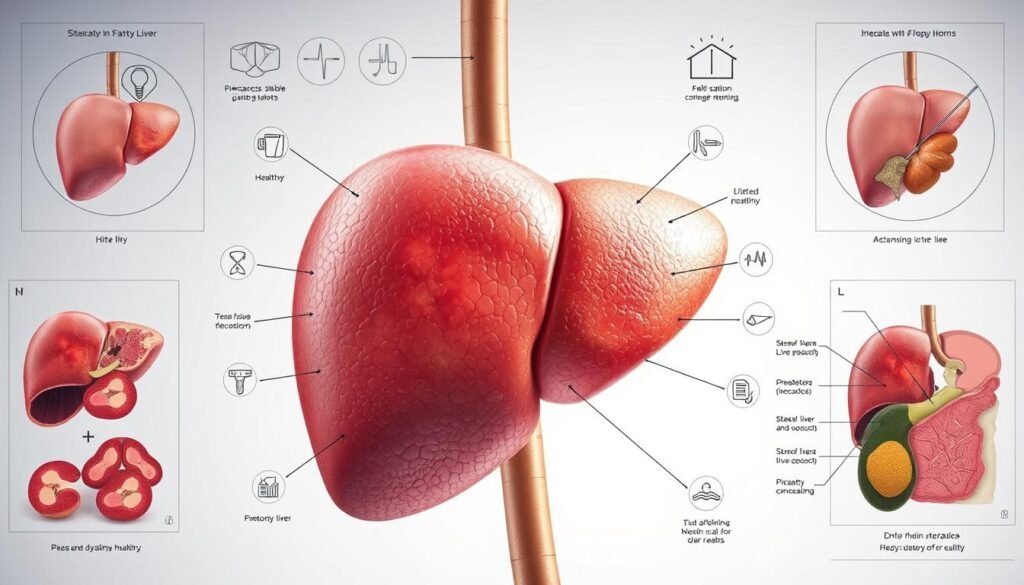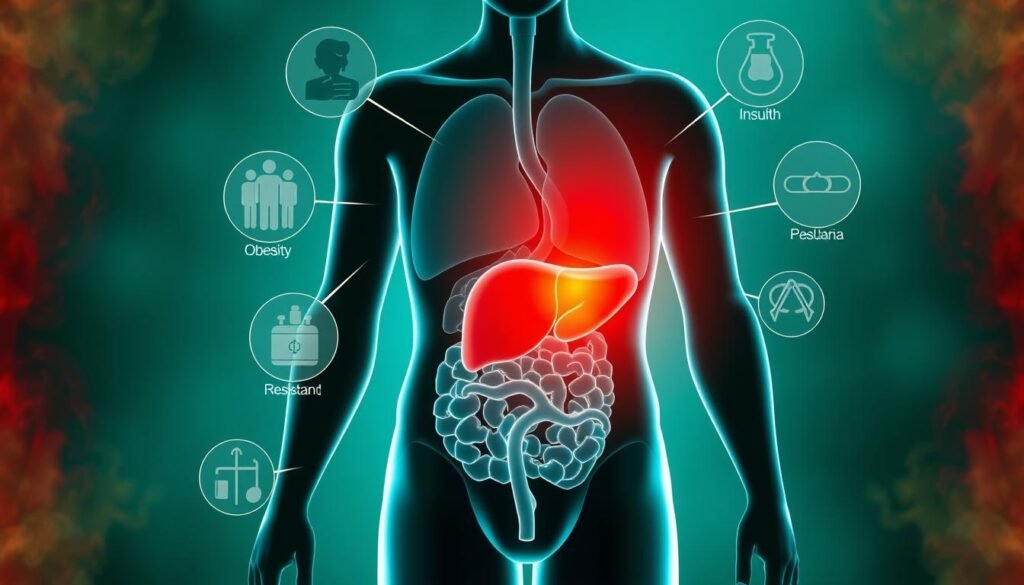Ever thought about how the liver, key for metabolism, can store extra fat without any signs? This condition, called Simple Fatty Liver, is a part of Nonalcoholic Fatty Liver Disease (NAFLD). It’s key to know about it for those curious about liver health and overall well-being.
Simple Fatty Liver means having extra liver fat, but no inflammation or damage. It’s a less severe type of NAFLD. Today, about 25% of people worldwide have NAFLD. It’s crucial to know how it can lead to worse liver problems. Being overweight or having diabetes puts you at higher risk. To learn more, see more about Nonalcoholic Fatty Liver Disease.
Key Takeaways
- Simple Fatty Liver is a benign condition characterized by fat accumulation without liver damage.
- Approximately 25% of the global population is affected by Nonalcoholic Fatty Liver Disease.
- Awareness of Simple Fatty Liver is crucial for early detection and preventing severe liver conditions.
- Environmental factors like diet and lifestyle significantly influence liver health.
- Simple Fatty Liver may progress into more serious conditions if not managed properly.
Introduction to Fatty Liver Disease
Fatty liver disease includes several liver issues caused by too much fat in liver cells. About 100 million people in the United States have it. Nonalcoholic fatty liver disease (NAFLD) is the most common type, affecting 24% of adults.
NAFLD’s rate has doubled over the last 20 years. It’s a big concern for liver health. It can affect anyone, even pregnant women, due to hormonal changes and insulin resistance.
Often, fatty liver diseases show no symptoms, making them easy to miss. Untreated, they can lead to severe complications like NASH. This condition causes liver inflammation and scarring. Both alcoholic and nonalcoholic fats in the liver have different risk factors. Heavy drinking can impact women more. It’s important to know about these diseases and how to prevent them.
What is Simple Fatty Liver?
Simple Fatty Liver is also known as steatosis. It’s the early phase of a condition called nonalcoholic fatty liver disease (NAFLD). The liver starts to gather fat, yet without significant harm. Knowing about what is Simple Fatty Liver? is crucial. Many people find they have NAFLD when they’re in this initial stage. Here, the liver has fat deposits, but without the harmful effects seen in later stages.
Definition and Characteristics
Simple fatty liver signals a problem but isn’t a direct threat. It’s often found by chance when checking for other health issues. Spotting simple fatty liver characteristics means noticing there aren’t symptoms seen in worse liver conditions. While not dangerous at once, some cases can lead to serious liver problems if not managed.
Comparison with Other Types of Fatty Liver Disease
Understanding the differences among fatty liver diseases is key for liver health. Simple fatty liver does not have inflammation or fibrosis, unlike its next stage, non-alcoholic steatohepatitis (NASH). Progressing from simple fatty liver can result in conditions like cirrhosis. Below is a summary of how these stages differ:
| Feature | Simple Fatty Liver | NASH |
|---|---|---|
| Fat Accumulation | Yes | Yes |
| Inflammation | No | Yes |
| Fibrosis | No | Possible |
| Symptoms | Absent | Possible |
| Progression Potential | Low | Higher |
Understanding Nonalcoholic Fatty Liver Disease
Nonalcoholic Fatty Liver Disease (NAFLD) is a major health issue in the U.S. It happens when fat builds up in the liver, but not from drinking too much alcohol. NAFLD can show up in different ways, which makes understanding it important.
Overview of NAFLD
NAFLD is the top reason for abnormal liver tests in Americans. About 100 million people, or 25% of Americans, have it. It’s often linked to obesity, high cholesterol, diabetes, and pre-diabetes. These are all part of what’s called metabolic syndrome.
The disease ranges from Simple Fatty Liver to the more serious Nonalcoholic Steatohepatitis (NASH). NASH causes liver inflammation and can lead to cirrhosis.
Types of Nonalcoholic Fatty Liver Disease
It’s crucial to know the different types of NAFLD for proper management and treatment. The main types are:
- Simple Fatty Liver (Steatosis): Just fat in the liver, without inflammation or much damage.
- Nonalcoholic Steatohepatitis (NASH): This type has inflammation and can cause serious liver problems like fibrosis or cirrhosis if not treated.
- Fibrosis and Cirrhosis: These are late stages where scar tissue takes over healthy liver tissue, hurting liver function.
Catching NAFLD early and changing your lifestyle is key to managing it. Losing weight, exercising, and eating right can greatly help your liver and health. For more on liver inflammation and what causes it, visit this resource.
Liver Steatosis: The Medical Terminology
Liver Steatosis, often called fatty liver, is a serious condition. It happens when fat builds up in liver cells. If fat makes up more than 5% of the liver’s weight, it’s a concern. Knowing about medical terminology helps doctors and patients spot liver problems early. It also helps improve liver health.
The name for this condition has changed over time. Now, it’s often called metabolic dysfunction-associated steatotic liver disease (MASLD). This condition affects many, including middle-aged adults, children, and young adults. It’s not limited by age.
Obesity, high levels of fat in the blood, and type 2 diabetes are linked with liver steatosis. People with metabolic syndrome are at a greater risk for liver and heart diseases. MASLD is tricky because it may not show symptoms. This makes finding and treating it early hard.

Learning these terms helps in finding liver problems early. For a clear diagnosis, doctors may need to use advanced scans or even a liver biopsy. Sometimes, scans alone can’t confirm steatosis.
Keeping your liver healthy is tied to your lifestyle choices. Eating well, staying active, and seeing your doctor regularly can lower your risk. This helps keep liver steatosis at bay and supports overall health.
Fatty Liver Causes
It’s important to know what causes fatty liver disease. This helps in both preventing and managing it effectively. Some key risk factors include being overweight, insulin resistance, and genetics. Being aware of these can prevent serious health issues.
Risk Factors Associated with Simple Fatty Liver
Some risk factors for fatty liver come from lifestyle and health. A major one is obesity, affecting about 25% worldwide with nonalcoholic fatty liver disease (NAFLD). Other risks include type 2 diabetes and high cholesterol. In the U.S., it’s now the most common liver condition.
Genetic and Lifestyle Influences
Genetics also influence who might get fatty liver, especially in heavy drinkers. Poor diet and lack of exercise play big parts too. Making positive changes in these areas can lower risks. For more on fatty liver causes and how to avoid them, visit trusted health sites.
Fatty Liver Symptoms
Knowing if you have fatty liver disease early can help you manage it better. Simple Fatty Liver often shows no signs, so many don’t know they have it. When signs like fatigue and upper right abdomen discomfort do appear, it’s key to act fast. This leads to better health results by catching Fatty Liver Symptoms early.
Common Symptoms of Simple Fatty Liver
Even though many with Simple Fatty Liver feel fine, some do have symptoms. It’s important to pay attention to common symptoms, such as:
- Fatigue
- Discomfort or pain in the upper right abdomen
- Unexplained weight loss
- Weakness
- Nausea or loss of appetite
These signs are often mild but could mean you need more tests. Especially those with obesity, type 2 diabetes, or high cholesterol should watch out.
Differentiating Between NAFLD and NASH
Knowing the difference between NAFLD and NASH is important. NAFLD just means there’s fat, with no inflammation. But NASH means inflammation and cell harm are happening. This is serious because inflammation can lead to bigger problems like cirrhosis and liver cancer. Around 20% of those with NAFLD might get NASH. Keep an eye on it and know about NAFLD vs NASH to seek the right help. For more on fatty liver, check out this page.
Diagnosing Simple Fatty Liver Disease
To diagnose Simple Fatty Liver Disease, doctors look at patient history and tests. Knowing a patient’s medical history helps spot risk factors for the disease. Often, doctors will do a detailed examination to look for symptoms. Yet, many people don’t show clear signs of having the condition.
Medical History and Physical Examination
Reviewing a patient’s medical history is key. This looks at weight changes, diet, and family liver disease history. The doctor then checks for liver problems, like belly swelling or skin color changes, during the exam. What they find out here can show who needs more testing.
Testing and Imaging Techniques
Doctors start with blood tests to check liver health. They look at enzymes like ALT and AST. High levels suggest Simple Fatty Liver Disease might be present. Then, doctors may use imaging techniques such as ultrasound or MRIs to see if there’s fat in the liver.
Even though these images show fat, they don’t show inflammation or scarring. Technologies like elastography check for liver stiffness and can hint at fibrosis. If there’s a chance of serious disease, a liver biopsy might be done. This check is vital to figure out Nonalcoholic Steatohepatitis (NASH) or how bad the disease is. Getting the right diagnosis early is crucial for managing the condition well. For detailed info on diagnosis, click here.
Fatty Liver Diet: What to Eat and Avoid
A suitable Fatty Liver Diet is vital for liver health and can possibly reverse Simple Fatty Liver. Eating healthy lowers the fat in the liver and boosts wellness. Here are the main diet tips:

- Added sugars
- Refined carbohydrates
- Fried foods
- Red meat (high in saturated fats)
- Processed meats
To boost liver health, you should eat more of these foods:
- Fruits and vegetables, like raw spinach
- Whole grains
- Legumes, including beans and lentils
- Fish rich in omega-3 fatty acids
- Nuts to reduce inflammation
- Turmeric, which may lower liver damage
- Sunflower seeds, full of vitamin E
Here’s a simple meal plan for a fatty liver:
- Breakfast: Oatmeal with almond butter and berries
- Lunch: Grilled chicken salad
- Snack: Peanut butter with apples
- Dinner: Grilled salmon with mixed beans
The Mediterranean diet, rich in plants and healthy fats, is especially good. Drinking up to three cups of coffee daily may also lower fatty liver risk. Exercise, weight control, and watching blood sugar are key for liver health.
Dietitians can create personalized nutrition plans. They ensure you follow the right guidelines for an effective Fatty Liver Diet.
Fatty Liver Treatment Options
Treating Simple Fatty Liver needs a focus on lifestyle changes. No specific drugs are approved for it by the FDA. Losing weight is key. Dropping just 5-10% of body weight can make a big difference for the liver.
Eating better helps too. A diet low in saturated fats, sugars, and refined carbs is recommended.
Exercise is also important. It helps with losing weight and could make the body use insulin better. This is good for the liver. Experts suggest doing moderate exercise for at least 150 minutes every week.
Keeping an eye on liver health is crucial for those with fatty liver disease. Doctors might use ultrasounds or MRIs. These tests check how much fat and scarring is in the liver.
- Maintain a balanced diet rich in fruits, vegetables, and whole grains.
- Engage in regular physical activity, aiming for at least 150 minutes weekly.
- Monitor liver function with regular medical check-ups.
- Limit alcohol intake as it can worsen liver problems.
Though scientists are still looking for medication treatments, right now, managing a healthy lifestyle is the best advice.
| Aspect | Details |
|---|---|
| Weight Loss | 5-10% reduction can improve liver health |
| Dietary Changes | Low in saturated fats, sugars, and refined carbs |
| Exercise | 150 minutes of moderate-intensity per week |
| Monitoring | Regular check-ups and imaging tests for liver assessment |
| Alcohol Consumption | Limit intake to reduce liver strain |
The Link Between Fatty Liver and Metabolic Syndrome
It’s vital to understand how fatty liver disease and metabolic syndrome are linked. These conditions often go hand in hand, affecting health deeply. Fatty liver is commonly found with metabolic syndrome. This syndrome includes issues like obesity, high blood pressure, and unhealthy cholesterol levels. With more people becoming obese worldwide, fatty liver disease is becoming a more significant concern.
Understanding the Connection to Obesity
In Western countries, upto 30% of people have non-alcoholic fatty liver disease (NAFLD). The link between NAFLD, metabolic syndrome, and obesity is strong. Almost 90% of those with NAFLD also have several metabolic syndrome features. This means a lot of people are dealing with both obesity and fatty liver. This increases their risk for other long-term health problems.
Being overweight makes fatty liver more likely. For obese people, the chance of having NAFLD can be as high as 75%. Those between 40 and 49 years old see the highest rates of fatty liver. This shows how age plays a role in these health issues too.
Data highlights the worrying link between metabolic syndrome and fatty liver disease:
| Study/Survey | Findings |
|---|---|
| National Health and Nutrition Examination Survey (NHANES) | Reported metabolic syndrome prevalence: 24.1% (1988-1994), 27% (1999-2000) |
| Greece Study (2003) | Metabolic syndrome prevalence in general population: 23.6% |
| Obesity in Mexico | 30% obesity rate indicates NAFLD potential of 20% |
| NAFLD Patient Statistics | About 33% of NAFLD patients exhibit three or more metabolic syndrome criteria. |
By managing obesity, we can greatly cut down the risks linked to both fatty liver disease and metabolic syndrome. Spreading awareness and education on this topic is key. It will help in preventing and effectively dealing with these health issues.

Tips for Supporting Liver Health
Keeping your liver healthy is vital and involves a healthy lifestyle. Using good strategies can greatly improve liver support. It also lowers the chance of diseases such as nonalcoholic fatty liver disease.
Here are some great tips for liver health:
- Balanced Diet: Eat lots of fruits, vegetables, whole grains, and healthy fats. Stay away from saturated fats and processed foods.
- Regular Exercise: Try to get at least 150 minutes of exercise that makes you breathe a bit harder every week. This helps keep your weight in check.
- Limit Alcohol: Drinking less alcohol helps your liver. Men should drink no more than four ounces of hard liquor daily, and women should limit to two ounces.
- Vaccinations: Getting shots for hepatitis A and B can protect your liver from these harmful viruses.
- Monitor Weight: Losing about 7% of your body weight can help get rid of nonalcoholic steatohepatitis.
- Manage Medical Conditions: Keeping diabetes and high cholesterol under control can also protect against fatty liver disease.
Putting these easy, effective tips into action can help keep your liver healthy. Being proactive helps make sure your liver is supported well. This is key for a healthy, strong body.
Conclusion
Simple Fatty Liver is a condition many people don’t know they have. Yet, it’s important for liver health. Around 25% of people worldwide are affected. Knowing about it helps manage the disease better. We must understand its signs, and what it means for our health.
Lifestyle choices greatly influence Simple Fatty Liver. This includes eating too much, not moving enough, and enjoying Western diets. For those at risk, changing diet and lifestyle is key. It can stop the disease from getting worse. Starting early means a better quality of life. It also lowers the risk of serious health issues like NASH and heart disease.
With more people getting Simple Fatty Liver, talking to doctors is crucial. Being informed helps manage the condition. This way, everyone can aim for a healthier future. It also helps dodge worse problems from untreated liver diseases.